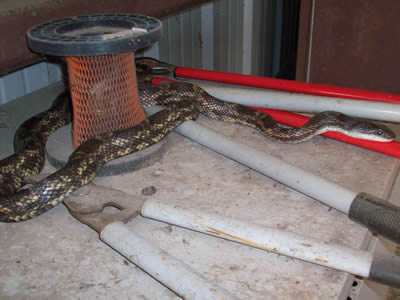
With overgrown vegetation and a large pond nearby, the Hydraulics, Sedimentation, and Erosion Control Lab (HSECL) at the Riverside Campus attracts more than its share of critters. Mice and rats are the most common non-human visitors to Building 7030 (the technical name for the HSECL’s location).
According to Associate Research Specialist Derrold Foster, the most memorable guest to date stopped by recently as he was conducting a rainfall simulation test.
“Something slithering through our opened doorway caught my eye a couple of weeks ago,” Foster recalls. “It just kept coming and coming.” It turned out to be a very large Texas Rat Snake (commonly called a Chicken Snake). About six-feet long, the snake made its way into the building as if it owned the place.
“We do occasionally have some poisonous snakes around the building, but this one was completely harmless. I just let it be,” he says. Foster is hoping the snake will be useful and eliminate some of those unpleasant rats and mice.